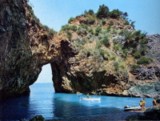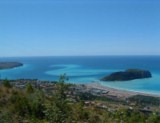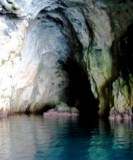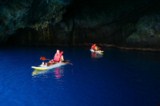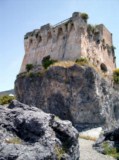|
PRAIA A MARE - CALABRIA- SOUTH ITALY
HOTEL ROOMS ACCOMMODATIONS OFFERS IN PRAIA A MARE
WHERE TO EAT WHERE TO HAVE FUN EXCURSIONS SPONSORS Praia a Mare stands by a long sandy beach and is the first resort that you meet along the Tyrrhenian coast coming from North. It stands opposite the mythical Island of Dino where legend says "Ulysses" once landed. This Island has 4km of coastline and steep slopes that end in wonderful, most enchanting natural grottos such as "The Grotto of the Lion" that entering in the mysterious darkness, you can spot a rock that takes the shape of a sitting Lion; the "Azure" Grotto that you'll never want to leave for it's gentle and most amusing Azure colour reflection of the sea; the "Grotta del Frontone" a huge, deep and almost unexplored grotto rich in stalactites and stalagmite or even the "Grotta delle Cascate" housing little hollows and whitish formations deposited by the water dripping from the grotto's ceiling. Opposite the Island, on the edge of the upland plain called "Pianoro della Foresta" sits a medieval castle very well-preserved, commanding a view of all the surrounding area. Praia a Mare as well as many other towns with a great deal of history of the South of Italy, had it's own sentinel tower built in the 16th century proving the inhabitants efforts to fight back to the Turkish raiding.
The historic evolution of this sea town is closely bound with the existence of a magnificent sea-cave named "Grotta della Serra Vingiolo". This grotto consists of three interconnected caves each with an independent access from sea it was a living environment for a Mediterranean race of Homo Sapiens who lived there for thousands of years. This Grotto has given light to many historic remains of Homo Sapiens such as stone objects, painted pebbles featuring anthropomorphic patterns, light yellow pottery decorated with winding patterns with handles featuring of animal heads, and fragments of late Roman sealed ceramic objects, oil lamps, bowls. In the 10th century this cave became the area where Greek monks staged their dwellings, later it became a monastery consecrated to St. Elias. On Praia's hilltops lays another natural grotto that can be reached by a long flight of steps housing the sanctuary of "Santa Maria della Grotta". This sanctuary hosts a wooden statue of the Madonna and Child that dates back to 14th century and a marble statue of the Madonna della Neve of the 17th century. Much of Praia's history is contained in this grotto where many Palaeolithic, Neolithic and Roman articles have been found. |
||||||||


